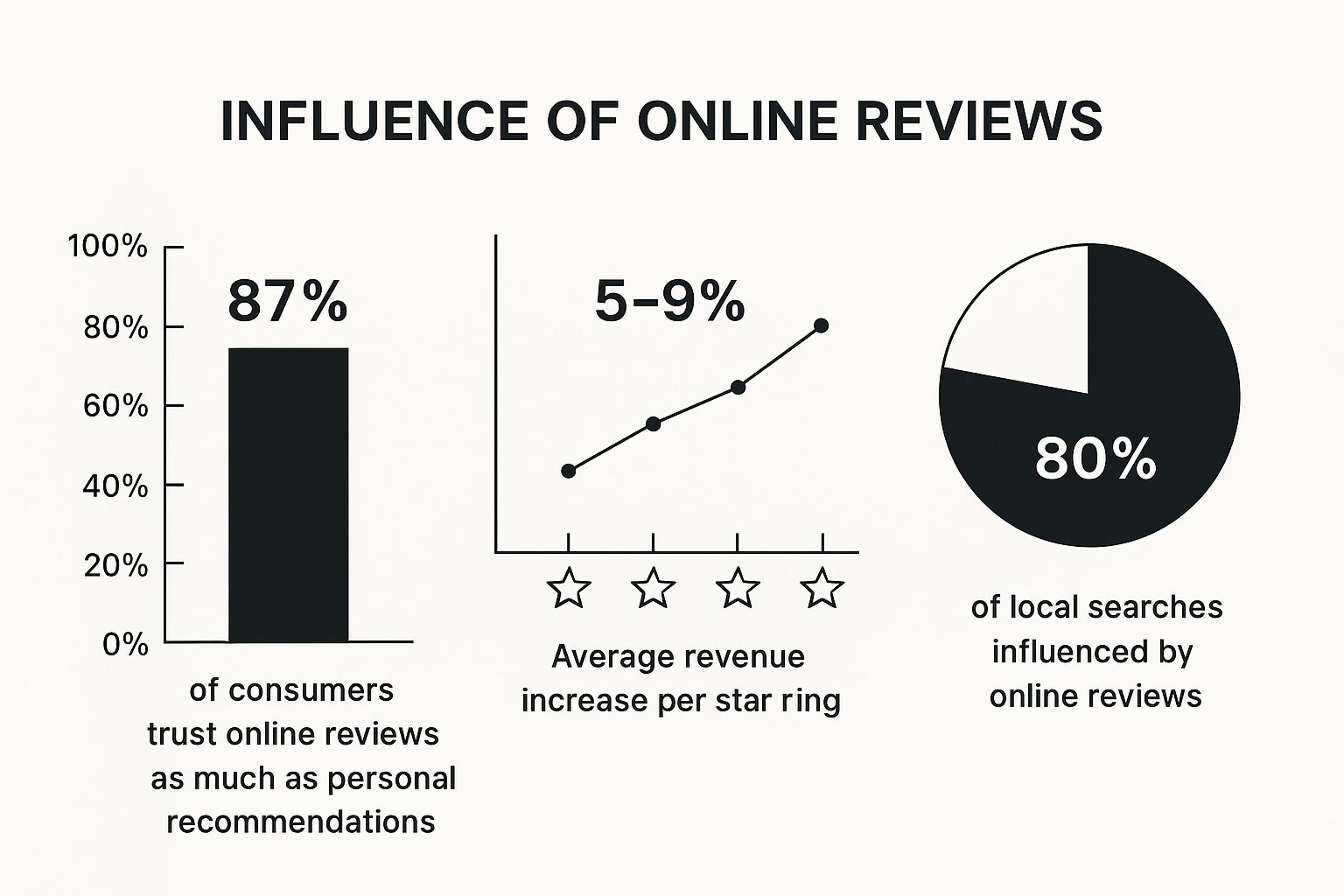Hoping your customers will magically leave you feedback isn’t a business strategy. To build the trust and online visibility you need, you have to get comfortable with one simple action: you must ask for review on google. It’s a proactive approach that has become an essential driver for any modern business, directly shaping how new customers find and perceive you online.
Why Asking for Google Reviews Is a Non-Negotiable Strategy
Think of it this way: word-of-mouth used to happen over the back fence. Today, it happens on Google. A steady stream of fresh, positive reviews is one of the most powerful marketing assets your business can have. It’s the digital equivalent of social proof, convincing potential customers to choose you over the competition down the street.
And this isn’t just about getting a pat on the back; it’s about real, measurable growth. When you figure out a solid system for how to ask for a review on Google, you directly improve three critical parts of your business:
- You Build Instant Trust: Let’s face it, people are looking for unbiased opinions. A healthy collection of recent reviews shows them your business is legitimate, that other people value your work, and that you’re reliable.
- You Improve Your Local SEO: Google’s algorithm absolutely pays attention to businesses with frequent, positive reviews. More feedback can give you a significant boost in local search results and on Google Maps, making it a heck of a lot easier for nearby customers to find you. To dig deeper into this, check out our guide on how Google reviews help SEO.
- You Drive More Conversions (and Revenue): Positive ratings directly influence buying decisions. Sometimes, a higher star rating is the only thing that tips the scale in your favor when a customer is weighing their options.
The Real-World Impact of Your Google Reviews
The data doesn’t lie. A passive “wait and see” approach to reviews means you’re leaving money on the table. This table breaks down just how much those stars and comments matter to your bottom line and customer perception.
| Metric | Impact Percentage |
|---|---|
| Consumers Who Trust Reviews | 74% |
| Consumers Who Use Google for Reviews | 88% |
| Customers Influenced by Positive Reviews | 93% |
| Consumers Expecting a 4-Star Rating | 57% |
This data paints a clear picture: what your customers say online directly impacts your credibility and your sales.
This infographic visualizes just how much reviews influence trust, revenue, and your performance in local search.

As you can see, the vast majority of consumers now treat online reviews like personal recommendations from friends, directly linking your star rating to your potential for growth.
The reliance on Google for business feedback is undeniable. Statistics show that a staggering 88% of customers use Google Business reviews to evaluate a local company’s reputation before they ever make a purchase. On top of that, about 74% of consumers say they have greater trust in businesses that have a solid track record of positive reviews. It’s a make-or-break element for building credibility from day one.
Here’s the key takeaway: what others say about your business will always carry more weight than what you say about yourself. Every single positive review is a vote of confidence that works for you 24/7. It builds a reputation that keeps attracting new clients long after the feedback was left.
While Google reviews are a powerhouse, it’s also smart to understand the broader landscape of effective customer feedback collection tools to round out your strategy.
By creating a simple, consistent process to ask for a review on Google, you effectively turn your happy customers into a powerful, self-sustaining marketing engine that fuels your growth.
Laying the Groundwork for a Positive Response

Before you even think about the perfect way to ask for a Google review, you need to create an environment where customers actually want to share their positive experiences. Sending a brilliant request to an unhappy customer is a waste of time. The real work starts long before you ever hit “send.”
This prep phase is all about making sure your business looks professional online and that your customer service is genuinely review-worthy. Think of it as setting the stage for a five-star performance. When the foundation is solid, asking for a review feels like a natural and welcome next step.
Optimize Your Digital Front Door
Your Google Business Profile (GBP) is your new front door. It’s often the very first impression a potential customer gets, and it’s exactly where their review will live. A half-baked or outdated profile looks unprofessional and just makes things harder for everyone.
Before you start asking for more reviews, give your profile a quick audit.
- Accurate Information: Is your address, phone number, and hours 100% correct? Nothing sours an experience faster than a customer driving to your shop only to find it closed because your hours were wrong online.
- Recent, High-Quality Photos: Get some clear, current photos up there. Show off your storefront, your products, and your team. It’s a simple step that builds trust and proves you’re an active, professional operation.
- Complete Services Section: Don’t be vague. Clearly list everything you offer. This not only helps customers find what they need but also boosts your local SEO by hitting those important keywords.
A well-maintained profile tells both Google and your customers that you care and you’re paying attention. That small effort makes a huge difference when your review request lands in their inbox.
The best review requests are just an extension of an already excellent customer experience. If the service is memorable, the customer is primed to share their story before you even have to ask.
Create a Review-Worthy Experience
Here’s the honest truth: the most critical factor in getting a positive review is providing an experience that inspires one. People don’t take time out of their day to write about “okay” or “fine.” You have to create moments that genuinely stand out.
This doesn’t mean you need a massive budget for over-the-top gestures. It’s the small, intentional touches that have the biggest impact.
Think about a barista who remembers a regular’s order, or a contractor who leaves a workspace cleaner than they found it. These are the moments that make a customer feel seen and valued, not just like another transaction.
When you consistently deliver exceptional service, asking for feedback feels less like a chore and more like inviting customers to share a genuinely good story. This completely changes the dynamic, making it far easier to ask for review on google and get a fantastic response.
Crafting a Review Request That Actually Works

How you ask for a review is just as crucial as the amazing service you just delivered. A generic, robotic message gets deleted without a second thought. But a genuine, thoughtful request? That’s what makes a customer feel appreciated enough to share their experience. It’s the difference between being ignored and earning a glowing five-star recommendation.
This isn’t just a “nice-to-have” skill. In a world where over 99% of American consumers read online reviews, your reputation is everything. While most happy customers are willing to leave feedback, very few will do it on their own.
But here’s the kicker: a whopping 77% of users say they’d leave a review if a business simply asked. That’s a huge, untapped opportunity for anyone willing to make the first move.
Personalize Your Approach
Nobody likes feeling like they’re just another number on a mass email list. To truly get a customer’s attention, you have to make them feel seen. A little personalization goes a very long way.
Instead of a boring “Leave us a review,” get specific. Reference the actual service or product they loved.
For a landscaping company, you could say, “We hope you’re loving the new patio!” For a retail shop, something like, “How are you enjoying that new espresso machine?” works wonders.
This tiny detail does two powerful things:
- It proves a real human is behind the message, not an automated bot.
- It instantly reminds the customer of their positive experience, making it much easier for them to write something meaningful.
A personalized request isn’t just good manners; it’s a psychological trigger. It reinforces the positive feelings a customer has about their purchase, making them far more likely to turn those feelings into a public review.
Make the Process Effortless
Let’s be honest—the biggest reason people don’t leave reviews is friction. If they have to hunt down your Google Business Profile, figure out where to click, and then think about what to write, you’ve already lost them. Your job is to make it ridiculously easy.
The goal should always be to get them from your message to the review form in a single click. No exceptions.
Always, always provide a direct link that takes them exactly where they need to go. If you’re sending a text or using printed materials, use a link shortener like Bitly to make it clean and simple.
A strong, friction-free request has a clear call-to-action (CTA) with that direct link. For example: “Could you take 60 seconds to share your experience on Google? You can leave your feedback right here: [Direct Review Link].” This sets a clear, low-effort expectation. If you’re struggling to find the right words, check out our guide on how to ask for reviews without sounding pushy.
Adapt Your Message to the Medium
The perfect message sent through the wrong channel will fall flat. You need to tailor your request to the platform you’re using.
- Email: This is your chance to add a bit more detail. You can thank the customer personally, reference their specific purchase, and briefly explain why their feedback is so important. Just keep it scannable with short paragraphs and a clear CTA.
- SMS/Text: Keep it short and sweet. A friendly, concise message with a direct link is the name of the game. Try something like: “Hi [Name]! Thanks again for choosing us. If you have a moment, we’d love your feedback on Google: [Link].”
- In-Person: The absolute best time to ask is right after a customer gives you a compliment. When they say, “This is amazing!” you can follow up with, “That’s so great to hear! If you get a chance later, sharing that on our Google profile would help us immensely.”
By making your request personal, simple, and context-aware, you turn a basic ask into one of your most powerful tools for building an unbeatable online reputation.
Finding the Perfect Moment to Ask
When it comes to getting a great review, timing isn’t just one thing—it’s everything. Asking for feedback is a bit like telling a good joke; the delivery and timing make all the difference. Get it right, and the request feels like a natural, welcome part of the conversation. Get it wrong, and it’s just another email getting deleted.
The trick is to pinpoint the “happiness peaks” in your customer’s journey. These are the moments when they feel the most satisfied and impressed with your work.
If you jump the gun and ask too early, they haven’t had a chance to really appreciate what you’ve done for them. But if you wait too long, the initial excitement wears off, and your request just feels like another chore on their to-do list. You want to catch them while the positive experience is still fresh.
Capitalize on Customer High Points
The absolute best time to ask for review on google is right after a positive moment. Think about your own business—when does a customer feel that sense of relief or delight?
- After a successful outcome: The project is finished, their problem is solved, or the product just worked perfectly. A contractor finishing the final walkthrough of a stunning kitchen remodel knows this moment well.
- Following unsolicited praise: If a customer ever says, “Wow, you guys did an amazing job!”—that’s your cue. It’s the most organic time to thank them and gently suggest they share that experience online.
- Post-purchase for exciting products: That feeling right after someone unboxes a product they’ve been looking forward to? That’s a powerful moment to tap into.
On the flip side, never ask right after a tricky support call or a frustrating transaction, even if you managed to resolve it. Give them some breathing room first.
The perfect moment isn’t just about the clock; it’s about the context. Your request should feel like a natural extension of a great experience, not an awkward interruption. Catching that wave of positive emotion is what turns a happy customer into a vocal advocate.
Comparing In-Person vs. Automated Asks
How you ask is just as important as when. You’ve got two main approaches: asking in person or using an automated system. Honestly, the best strategies often use a bit of both.
| Method | Pros | Cons |
|---|---|---|
| In-Person Ask | Incredibly personal and effective, especially when you’ve just received a direct compliment. | Hard to scale for busy businesses and can feel a little awkward if you don’t nail the timing. |
| Automated Ask | Consistent, scalable, and makes sure you don’t miss anyone. Can be triggered by events like a purchase or delivery. | Lacks that personal touch and can be easily ignored if it feels too generic. |
Nailing this timing is a bigger deal than you might think. A steady stream of fresh reviews directly impacts about 10% of your local SEO ranking factors. What’s more, 73% of consumers say they only really trust reviews if they’re recent, which means you need a constant flow to stay credible. You can dig deeper into how recency builds trust in this detailed analysis of Google Review statistics.
Ultimately, it comes down to mapping out your customer’s journey and spotting those key moments of happiness. Once you know where they are, you can build a system around them—whether it’s a team member making a personal ask or a perfectly timed email. That’s how you turn a simple transaction into a powerful tool for building your online reputation.
How to Automate Your Review Process Without Sounding Like a Robot

Let’s be honest: manually asking every single customer for a review is a grind. It’s a great idea in theory, but as you get busier, it’s just not practical. Inevitably, opportunities get missed, and your team’s precious time gets eaten up by a repetitive task instead of focusing on what really matters—the customer experience.
This is where automation comes in, and it’s a total game-changer.
The idea isn’t to remove the human touch. It’s about building a smart system that ensures every happy customer gets a timely, polite nudge to share their thoughts. A well-designed automated workflow lets you consistently ask for a review on Google without ever sounding like a cold, impersonal machine. It’s all about using technology to trigger requests at the perfect moment.
Finding the Right Automation Tools for the Job
There are a bunch of tools out there that can help you create an automated review-gathering machine. They range from simple setups to incredibly powerful platforms. The right one for you really depends on the tools you’re already using and how many customers you’re serving.
Here’s a breakdown of the common options:
- Simple Email Triggers: If you’re using a platform like Mailchimp or Klaviyo, you can set up an email to automatically go out after a customer buys something or their order is delivered. For e-commerce businesses, this is a fantastic place to start.
- CRM Integrations: Your CRM is a goldmine. You can build workflows that send a review request a few days after you’ve closed a service ticket or finished a project. This ties the “ask” directly to a recent, positive experience.
- Dedicated Reputation Management Platforms: For any business that’s serious about scaling, specialized software is the way to go. These platforms do it all—they send requests via email and SMS, track new reviews, and let you respond to everything from one central dashboard. It’s worth exploring the different types of customer feedback management software to see what’s possible.
The secret to great automation is that it should feel completely invisible to the customer. The request needs to show up at a time that makes sense and feel like a natural follow-up, not just another marketing blast.
Best Practices for Smart Automation
Flipping the “on” switch isn’t enough. If you don’t set up your automation thoughtfully, you risk annoying the very customers you’re trying to engage. A poorly planned system can backfire and make your brand feel spammy.
First things first, set frequency limits. You need to make sure a customer who buys from you multiple times in a short period isn’t getting bombarded. A good rule of thumb is to send only one review request per customer every 90 days. It’s respectful and effective.
Next, get smart with your messaging using conditional logic. You can change the request based on the exact product someone bought or the service they received. For example, the message you send a long-term landscaping client should be different from the one that goes to a customer who just bought a small plant from your nursery. This little bit of personalization makes a world of difference and helps your automated request feel genuinely human.
Turning Every Review into a Marketing Asset
Getting a new review is a great feeling, but the real work starts after it’s posted. How you respond to that feedback and, more importantly, how you use it, is where the magic happens. Every single review, from a glowing five-star rave to a stinging one-star critique, is a golden opportunity to polish your reputation and learn something valuable.
Responding to reviews isn’t optional—it’s essential. It signals to everyone looking at your profile that you’re paying attention and that you stand by your service. A simple “thank you” on a positive review makes that happy customer feel seen and encourages others to share their own experiences. For negative reviews, a quick and professional response can defuse a tense situation and show that you’re committed to making things right.
Responding to All Types of Reviews
Your approach to responding should be consistent but never cookie-cutter. A thoughtful, timely reply shows there’s a real human behind the business who genuinely cares about every customer. This simple act builds a mountain of public trust.
- Positive Reviews: Thank the customer by name. Try to mention a specific detail from their review to show you actually read it. This personal touch makes all the difference.
- Negative Reviews: Start by publicly acknowledging their frustration and apologizing for their poor experience. Then, offer to take the conversation offline to find a solution. This shows you’re accountable without starting a public back-and-forth.
The goal is never to win an argument online. It’s to show every potential customer reading the exchange that you handle criticism with grace and are dedicated to customer satisfaction. Honestly, that can be more powerful than a dozen five-star reviews.
Transforming Feedback into Marketing Gold
Your best reviews are basically free marketing material, just sitting there. They’re authentic, trustworthy endorsements that are far more convincing than any ad copy you could ever write. Don’t just let them gather dust on your Google Business Profile.
Start actively sharing this feedback across all your marketing channels. Pull out a great quote and turn it into a simple, eye-catching graphic for your social media feeds. Add a “What Our Customers Say” section to your website homepage and feature your most powerful testimonials. You can even sprinkle compelling quotes into your email newsletters or sales proposals to build instant credibility.
To really get the most out of this, you should be thinking about formalizing your user-generated content strategies. By systematically showcasing positive experiences, you create a powerful cycle of social proof that constantly attracts new customers and solidifies your great reputation.
Common Questions (and Straight Answers) About Google Reviews
Getting the hang of Google’s review policies can feel like you’re walking a tightrope. Let’s clear up a few of the most common questions I hear from business owners so you can ask for reviews with confidence.
Can I Offer a Discount or Gift for a Google Review?
The short answer is a hard no. Offering incentives—whether it’s a 10% discount, a free coffee, or a gift card—in exchange for a review is a direct violation of Google’s policies.
This is a big deal for Google because it undermines the authenticity of the whole system. They want real, unbiased feedback, not reviews that have been bought. Instead of trying to bribe customers, pour that energy into creating an experience so good they want to talk about it. An honest, earned review is worth far more than a dozen paid-for ones.
What’s the Best Way to Handle a Fake Negative Review?
It’s incredibly frustrating when a fake negative review pops up, but how you respond is what matters. Don’t panic or get into an online argument.
If you’re certain the review is fake or violates Google’s rules (like containing spam or hate speech), your first move should be to flag it. Just find the review, click the small three-dot menu, and hit “Report review.”
While Google looks into it, it’s smart to post a calm, professional public reply. Something like, “We appreciate all feedback, but we can’t seem to find any record of you in our customer system. We’d be happy to discuss this if you could please contact us directly.” This shows other potential customers that you’re on top of things and handle criticism gracefully.
How Many Times Is It Okay to Ask for a Review?
One well-timed request is usually all you need. Pestering a customer with follow-up after follow-up is a surefire way to annoy them and undo all the goodwill you’ve built.
My rule of thumb is this: send one polite, personal request. If they don’t respond, let it go.
My Two Cents: Your time is much better spent creating a smooth, consistent process to ask every new customer for a review, rather than chasing down the ones who didn’t respond the first time. A single, automated follow-up a week later is fine, but anything beyond that just feels desperate.
Ready to build a five-star reputation? Reviews To The Top gives you the tools to automate your review requests, manage feedback from one central dashboard, and turn your happy customers into your best marketing asset. Learn more and start your free trial.
